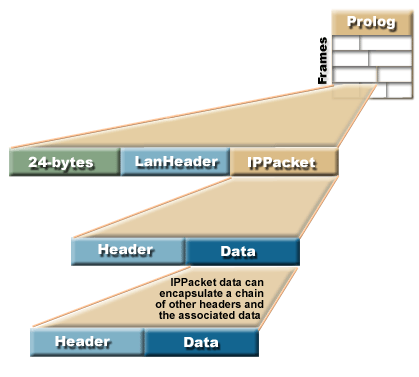The following illustration shows how the commtrace classes correspond to a communications trace file. The graphic also indicates the naming conventions that the commtrace classes use for the components in a communications trace.
Prolog: An initial 256-byte section of a communications trace for a LAN line description. The Prolog contains general information about the trace, such as start and end times, number of bytes collected, and so on.
Frame: Records of varying length that contain the data that the iSeries™ server transmitted during the communcations trace.

Each Frame in the trace file contains two initial sections (that provide general information about the contents of the frame) and the packet that the iSeries server transmitted between itself and a different point on the network.
The very first 24-byte section of data contains general information about the contents of the frame, such as the frame number and data length. Use the Frame class to process this information.
LanHeader: A section of data that occurs once in each frame (after the initial 24-bytes of data) and contains general information about the IPacket that follows.
IPPacket: A section of data, composed of one ore more headers and the associated data. IPPacket represents all the data packets that the network transmitted for this frame during the communications trace. IPPacket is an abstract class, so you will use the various concrete subclasses to process the headers and data in the packets.
Header: A section of data at the beginning of an IPPacket that describes the following packet data and, when appropriate, points to the next header. In the commtrace package, Header is an abstract class, so you will use the various concrete subclasses to process the data.